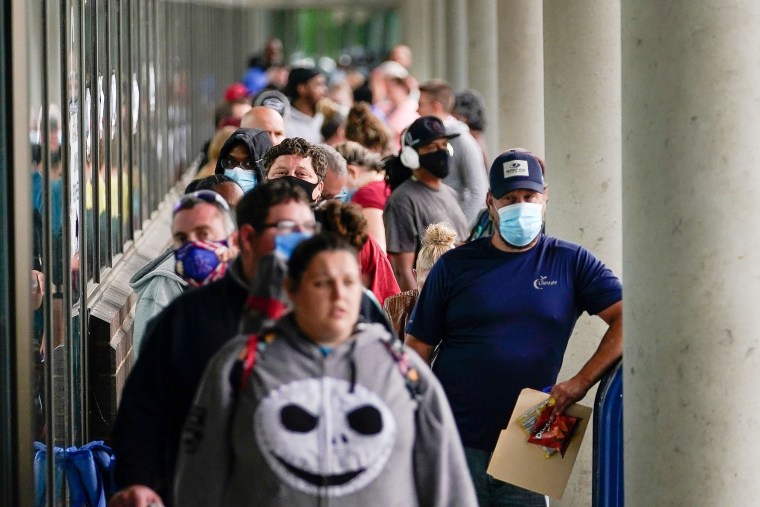Furloughed workers feel trapped in limbo as short-term layoffs drag on, with hundreds of thousands of employees not knowing when — or if — they will get called back to their job.
Workers across the country are struggling to figure out if they should wait for their "old" job to return or put their energy into finding new work, reducing housing costs, or pursuing new skills training.
“I've been told many times since June that I could get called back ‘any day now,’" said Laura, a strategist at Disney who asked that her last name be withheld due to concerns about losing her job.
“My entire life is on hold and I have to remain available,” she said. “I desperately want my job back. I have worked so hard to get to this point in my career and have a savings account. To realize that could be gone in just a few months time is terrifying."
Pandemic Unemployment Assistance, which provided $600 a week in additional relief for workers laid off due to the coronavirus, expired last month. With legislators still at a stalemate, families and workers are left scrambling.
Laura and her husband, who has kept his full-time job, said they had already cut back heavily on their spending, even when they received PUA. Without that additional funding, she said they now have to drain their savings to pay the bills.
"I have worked so hard to get to this point in my career and to have a savings account. To realize that could be gone in just a few months time is terrifying."
Employers and employees are both trying to game out the long term — but while businesses need to conserve cash and cut costs in order for there to be jobs for workers to go back to, the economic uncertainty and the recent resurgence in coronavirus infections has forced everyone into “wait and see” mode.
“People assumed this a short-term crisis and were put on furlough,” Martha Gimbel, a labor economist at Schmidt Futures, told NBC News. “They are slowly learning that this crisis isn’t going anywhere and those temporary layoffs are turning permanent,” she said.
Lainie Gulliksen 55, was a riverboat cruise singer for 30 years. Since the pandemic canceled cruises and many other travel and hospitality businesses, she’s been furloughed. Each month she thinks she’s going back to work, only to have the date pushed back again. One month, she thought she was going back to work and then four days before the return date, her company put her back on furlough.
In the past, she has always been able to find some kind work between gigs, she told NBC News. But this time is different.
“Given my age and lack of experience in anything else, it’s doubtful I’ll be able to find anything but a minimum wage job, if at all," Gulliksen said. "I’m at a loss."
For now, she has $275 a week to live on. She has enough savings for food and to pay rent for September, but is researching charities that might offer rent assistance.
“I’m not opposed to finding a job, but I worry about not making enough to live,” Gulliksen said.
According to the latest figures from the Bureau of Labor Statistics, the percentage of unemployed workers on temporary layoff dropped sharply in July, from nearly 60 percent to about 15 percent. Those not on temporary layoff jumped from 20 percent to just under 30 percent. That means many of those temporary layoffs are now permanent job losses.
For workers who were released in the early stages of the pandemic, their jobs may already have disappeared for good, new data suggests, since those businesses were likely not in a strong enough position to withstand further economic strain.
“If an employee was terminated in the midst of the strictest lockdowns in March and April and hasn’t been hired back already, they probably will not be rehired by that employer,” according to an analysis by payroll service provider Gusto of its client data.
However, an employer who introduced layoffs later in the cycle would be more likely to be able to recall those workers when lockdowns lifted, company researchers wrote. That's partly due to the Paycheck Protection Program, which offered low-interest and interest-free loans to keep small businesses afloat.
Narine Petrosyan, 29, moved from California to Florida for a new position as an assistant brand manager at Revlon just this past September. By March she was furloughed.
“I've been looking and already updated my resume. I'm really hoping to get my job back. I really enjoy what I did and love the brand,” Petrosyan said. “So I'm trying to stay positive, as hard as that is right now.”
If she knew for certain that she wouldn't be going back, she would “definitely” get more aggressive with her search, she told NBC News.
“If it doesn’t work out, I'll be back on the job hunt,” she said.

